Keywords
|
| Mobile adhoc network(MANET),Gateway node, Quality of services, Cellular network, Distributed network, Centralised network. |
INTRODUCTION
|
| A Mobile ad-hoc network (MANET) is a self-configuring infra-structure less network of mobile devices connected by wireless. Ad- hoc in Latin means for this purpose.Each device in a MANET is free to move independently in any direction, and will therefore change its links to other devices frequently. Each must forward traffic unrelated to its own use, and therefore be a router. The primary challenge in building a MANET is equipping each device to continuously maintain the information required to properly route traffic. Such networks may operate by themselves or may be connected to the larger Internet. |
| MANETs are a kind of wireless ad hoc networks that usually has a routable networking environment on top of a Link Layer ad hoc network. |
A. QOS AND ITS PARAMETERS
|
| Network Qos refers to the ability of the network to handle the traffic such that it meets the service needs of certain applications. |
| ïÃâ÷ Bandwidth - the rate at which an application's traffic must becarried by the network |
| ïÃâ÷ Latency - the delay that an application can tolerate in delivering a packet of data |
| ïÃâ÷ Jitter - the variation in latency |
| ïÃâ÷ Jitter - the variation in latency |
| ïÃâ÷ Low throughput - the bit rate that can be provided to a certain data stream may be too low for real time multimedia services if all data streams get the same scheduling priority. |
| ïÃâ÷ Dropped packet - The routers might fail to deliver (drop) some packets if their data is corrupted or they arrive when their buffers are already full. |
| Errors - Sometimes packets are corrupted due to bit errors caused by noise and interference, especially in wireless communications and long copper wires. |
| ïÃâ÷ Out-of-order delivery - When a collection of related packets is routed through a network, different packets may take different routes, each resulting in a different delay. The result is that the packets arrive in a different order than they were sent. |
RELATED WORK
|
| H. Luo, X. Meng, R. Ramjee, P. Sinha, and L. Li, propose the Unified Cellular and Ad-Hoc Network (UCAN) architecture for enhancing cell throughput, while maintaining fairness. In UCAN [1], [3], [8], a mobile client has both 3G interface and IEEE 802.11based peer-to-peer links. The 3G base station forwards packets for destination clients with poor channel quality to proxy clients with better channel quality. |
| In the paper[15], [12], [16], proposed a Link-Connectivity-Prediction-Based Location-Aided Routing (LLR) protocol specially designed for this hybrid network environment. They also propose a gateway discovery algorithm to help build K-hop subnets around gateways, which is fundamental to the routing protocol. The connection of ad-hoc networks to the Internet is typically established via gateways. The paper[2],[5],[6], presents a new gateway discovery algorithm based on HELLO messages of the AODV protocol and compares the performance of the new algorithm with standard proactive and reactive algorithms. Reference paper [11] examines the use of Mobile IP in order to provide global Internet connectivity to ad hoc network that use an on-demand routing protocol. We present a hybrid scheme that uses techniques such as TTL scoping of agent advertisements, eavesdropping and caching agent advertisements to combine the advantages of proactive and reactive approaches to providing connectivity. |
| The paper [4], [7] is a survey of mobility models that are used in the simulations of ad hoc networks.The goal of this paper is to present a number of mobility models in order to offer researchers more informed choices when they are deciding upon a mobility model to use in their performance evaluations. Specifically, they illustrate how the performance results of an ad hoc network protocol drastically change as a result of changing the mobility model simulated. |
| B. N. Park, W. Lee, C. Lee, and C. K. Shin, workson adaptiveQos-aware Internet Gateway (IG) selection scheme that selects a gateway based on two parameters that are the maximum residual capacity of an IG and the minimum hop-count of a path between a mobile node and an IG.The [10],[14] second parameter that has been considered for gateway selection is the hop-count between a MANET node or source node (s) and an IG or destination node (d), denoted as H(s, d) .In result, the hopcount parameter dominates the IG selection criterion. |
| A weight based gateway selection algorithm is proposed. It calculates the weights of gateway nodes by considering residual battery power, speed of a gateway node and number of hops. The gateway with a higher weight is selected as a default gateway. This scheme [13] slightly improves the network throughput; however, the end-to-end delay and packet drop ratio depends on the proper selection of the weighting factors, which is quite difficult in dynamic scenarios. |
EXISTING METHOD
|
| Gateway nodes provide a bridge between multiple networks and may be mobile or fixed. An ad hoc node must discover and select a suitable gateway node from a number of gateways before starting communication with the node in the infrastructure network. Hence, the gateway discovery and selection is an important factor to enable the integration between both networks. This research lies in the category of the gateway selection. Gateway selection is a process that selects a potential gateway node out of multiple discovered gateway nodes based on network, link, and path or gateway node parameters. |
| Different gateway selection schemes have proposed by considering various parameters. A gateway discovery message is broadcasted by the gateway and based on that message each node calculates its distance to the gateway. The gateway with the shortest path in terms of hop count is selected for relaying traffic from MANET to the infrastructure network. A gateway selection scheme that considers delay, jitter, hop count, and bit error rate as additive cost of a path or route between the MANET node to a gateway router and an edge gateway router. A gateway node that has a path with the minimum cost value is selected by the MANET node for Internet traffic. Another gateway selection scheme that considers Mobility Tracing-Value (MTV) as a basic criterion to select a gateway is proposed in. If a neighbouring node does not receive a Hello message until its duration expires, then the MTV value increases. These entire gateway nodes are selected based on considering any one single gateway selection method.Here, a gateway node is connected to only a two network. |
PROPOSED METHOD
|
| Mobile Ad hoc Networks (MANETs) are on demand, spontaneous, self-administrative, with no infrastructure and plugn- play networks. In interconnected MANET, the ad hoc network is connected with infrastructure network(s). |
| The communication between the infrastructure network and the MANET is provided by some MANET nodes called gateway nodes that are equipped with multiple interfaces. In the case of C2N using gateway node we are connecting two networks by a gateway node as shown in figure 1. Here the two networks are MANET and cellular network. Let the gateway node is defined as M.When a node from MANET sends a packet to a node of cellular network, it passes only through a gateway node. So that best quality of service is obtained considering all the parameters. |
A. ALGORITHM: C2N USING GATEWAY NODE
|
| 1.Connected Graph G(V, E). |
| 2.G ïÃÆß MANET. |
| 3.Cellular network G1(V, E) |
| 4.M ïÃÆàGateway node. |
| 5.From G(V, E) node send „PâÃâ¬ÃŸ to G1 (V,E). |
| 6.Transmissiontakes place via M. |
| Algorithm explains that G(V, E) is the first network that is MANET. Similarly G1(V,E) is the cellular network.M is the gateway node which connects these two networks. Suppose when a node from MANET sends the data or packets P to node in the cellular network it has to pass via a gateway node M. |
| C3N using gateway node we are connecting three networks by a gateway node. Let the three networks be MANET, cellular network and distributed network. The gateway node is defined as M.The gateway node connects all three networks as shown in figure 2.When a node from MANET want to sends a packet to a node of cellular network or distributed network,it passes only through a gateway node. The gateway node has all the parameters in built in it. |
B.ALGORITHM: C3N USING GATEWAY NODE
|
| 1.Connected Graph G(V,E). |
| 2.G ïÃÆß MANET. |
| 3.Cellular network G1(V,E). |
| 4. Distributed network G11(V,E). |
| 5.M ïÃÆàGateway node. |
| 6.From G(V,E) node send „PâÃâ¬ÃŸ to G1(V,E) or G11(V,E). |
| 7. Transmissiontakes place via M. |
| Algorithm explains that G(V,E) is the first network that is MANET. Similarly G1(V,E) is the cellular network. G11(V,E) is the third network that is distributed network. M is the gateway node which connects these threenetworks. Suppose when a node from MANET sends the data or packets P to node in the cellular network or distributed network it have to pass via a gateway node M. Comparing C3N algorithm with C2N algorithm the QOS parameters has slightly improved. |
| As shown in figure 3, C4N using gateway node we are connecting the four networks by a gateway node. Let the four networks beMANET, cellular network, distributed network and centralised network. The gateway node is defined as M.The gateway node connects all four networks.When a node from MANET want to sends a packet to a node to other network, it passes only through a gateway node. The gateway node has all the parameters in built in it which satisfies the QOS. |
C. ALGORITHM: C4N USING GATEWAY NODE
|
| 1. Connected Graph G(V,E). |
| 2. G ïÃÆß MANET. |
| 3. Cellular network G1(V,E). |
| 4. Distributed network G11(V,E). |
| 5. Centralised network G111(V,E). |
| 6. M ïÃÆàGateway node. |
| 7. From G(V,E) node send „PâÃâ¬ÃŸ to G1(V,E) or G11(V,E) orG111 (V, E). |
| 8. Transmission takes place via M. |
| Algorithm explains that G(V,E) is the first network that is MANET. Similarly G1(V,E) is the cellular network. G11(V,E) is the third network that is distributed network. G111(V,E) is the fourth network. M is the gateway node which connects these fournetworks. Suppose when a node from MANET sends the data or packets P to node in the cellular network or distributed or centralised network it have to pass via a gateway node M. When C4N algorithm is compared with C3N and C2N algorithm the parameters of gateway node is enhanced. |
EXPERIMENTAL RESULTS
|
| These algorithmsevaluate the performance of C2N and C3N algorithm and compare the performance with C4N network and also enhance the QOS of a gateway node between the networks. These algorithms are implemented using network simulator ns2.In the simulation we use 10 – 15 nodes in each network. |
| Packet delivery ratio, packet delivery time and packet drop ratio are some of the Qos parameters. Packet delivery ratio is obtained by dividing the number of data packets correctly received by the destinations by the number of data packets originated by the sources. Figure 4 shows the packet delivery ratio. Compared to C2N and C3N algorithmC4N using gateway node algorithm has highest packet delivery ratio. |
| Figure 5 shows the plot between number of nodes and dropping ratio. The analysis shows that the dropping ratio of a gateway node connecting two network is 0.65 and for three network is 0.54.The dropping ratio is 0.47 for gateway node connecting four network and the is least one. The dropping ratio for gateway connecting four networks is acceptable one when compared to other two networks. |
| Figure 6 shows the plot between number of nodes and number of cluster messages. From the analysis we can say that the number of cluster overhead for a gateway connecting four network is high when compared to other two and three networks connecting the gateway. |
| Normalized routing overhead is the ratio of the number of control packets propagated by every node in the network and the number of data packets received by the destination nodes. Figure 7 says that normalised routing overhead for gateway connecting two and three network is lower when compared to gateway connecting four networks. |
CONCLUSION
|
| The paper proposed and evaluated various QOS parameters such as path availability period, path load capacity, latency and gateway detecting algorithm for selecting a suitable gateway between mobile node and cellular node which satisfies all QOS and non-QOS parameters. More than two networks are connected to the gateway node and their various parameters are evaluated and their performance is compared. The results are verified using simulation and the simulation results shows that the proposed scheme enhances overall network parameters which includes throughput, success rate,capacity,path availability period and reduces packet drop, end-to-end delay and energy consumption per node compared to the conventional schemes. |
Figures at a glance
|
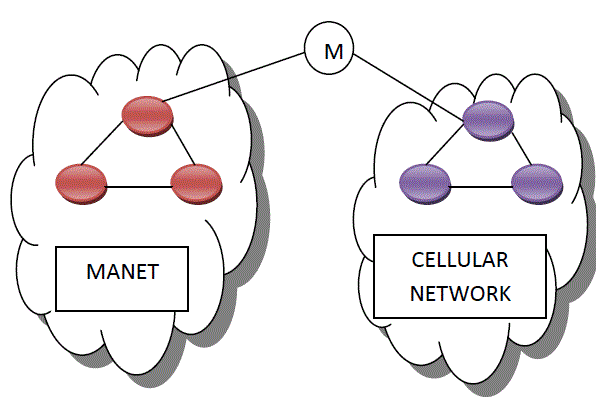 |
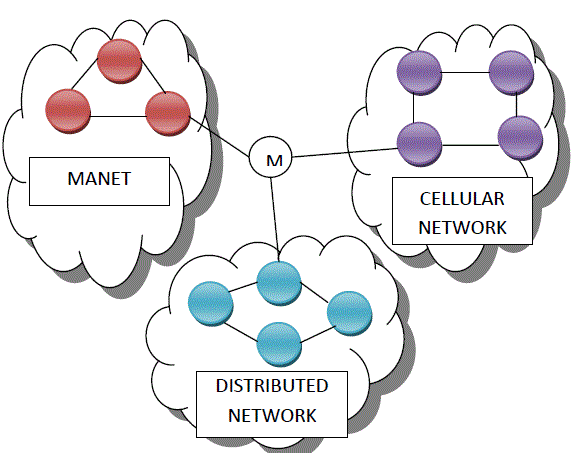 |
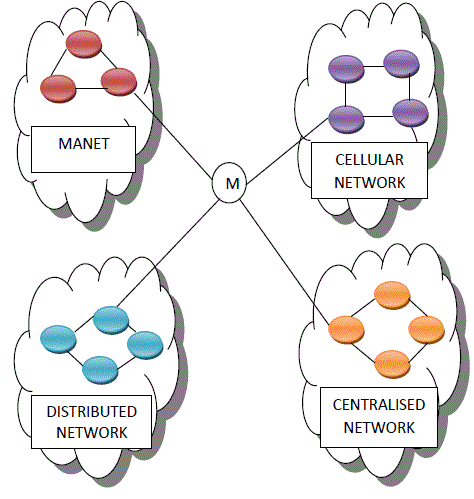 |
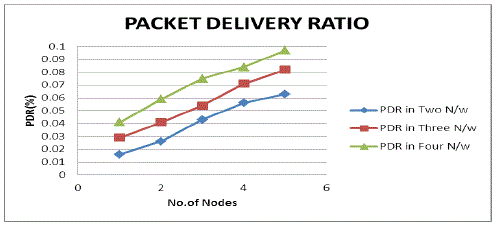 |
| Figure 1 |
Figure 2 |
Figure 3 |
Figure 4 |
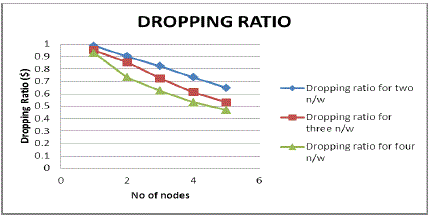 |
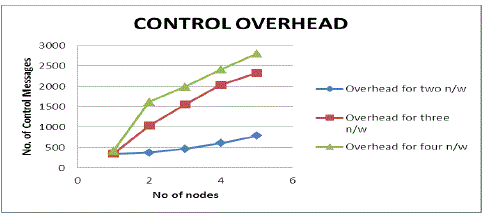 |
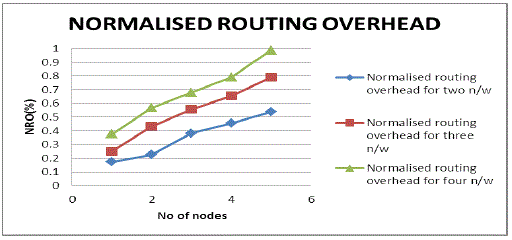 |
| Figure 5 |
Figure 6 |
Figure 7 |
|
References
|
- H. Ammari and H. El-Rewini, “Using hybrid selection schemes to support Qos When providing multihop wireless Internet access to mobile ad hocnetworks,” in Proc. IEEE QSHINE, pp. 148–155, Oct. 2004.
- G. Aggelou, Mobile Ad Hoc Networks: From Wireless LANs to 4G Networks, McGraw-Hill Professional, Nov. 2004.
- E. Baccelli, K. Mase, S. Ruffino, and S. Singh, “Address autoconfiguration for MANET: Terminology and problem statement,” IETF draft, Aug. 2008.
- T. Camp, J. Boleng, and V. Davies, “A survey of mobility models for ad hoc network research,” in WCMC, vol. 2, no. 5, pp. 483–502, 2002.
- M. C. Domingo, “Integration of ad hoc networks with fixed networks using an adaptive gateway discovery protocol,” in Proc. IET InternationalConferenceon Intelligent Environments, pp. 371–379, July 2006.
- M. Ghassemian, P. Hofmann, C. Prehofer, V. Friderikos, and H. Aghvami, “Performance analysis of Internet gateway discovery protocols in ad hocnetworks,” in Proc. IEEE WCNC, pp. 120–125, Mar. 2004.
- M. Ghassemian n, P. Hofmann, V. Friderikos, C. Prehofer, and A. H. Agh-vami, “An optimised gateway selection mechanism for wireless adhocnetworksconnected to the Internet,” in Proc. IEEE VTC,pp. 782–787, May 2006.
- H. Luo, X. Meng, R. Ramjee, P. Sinha, and L. Li, “The design and evaluation of unified cellular and ad-hoc networks,” IEEE Trans. Mobile Compute., vol.6, pp. 1060–1074, Sept. 2007.
- The Network Simulator-NS-2. Online.. Available: http://www.isi.edu/ nsnam/ns/
- B. N. Park, W. Lee, C. Lee, and C. K. Shin, “Qos-aware adaptive Internet gateway selection in ad hoc wireless Internet access networks,” in Proc.IEEEBROADNETS, pp. 1–10, Oct. 2006.
- P. Ratanchandani and R. Kravets, “A hybrid approach to Internet connectivity for mobile ad hoc networks,” in Proc. IEEE WCNC, pp. 1522–1527, Mar.2003.
- P. M. Ruiz, F. J. Ros, and A. F. Gomez-skarmea, “Internet connectivity for mobile ad hoc networks: Solutions and challenges,” IEEE Commun. Mag., pp.118–125, Oct. 2005.
- F. P. Setiawan, S. H. Bouk, and I. Sasase, “An optimum multiple metrics gateway selection mechanism in MANET and infrastructure networksintegration,” IEICE Trans. Commun., vol. E92-B, no. 08, Aug. 2009.
- B. Shen, B. Shi, B. Li, Z. Hu, and L. Zou, “Adaptive gateway discovery scheme for connecting mobile ad hoc networks to Internet,” in Proc.WiCOM pp.795–799.
- C. Shin, S. H. Kim, and S. An, “Stable gateway selection scheme based on MANET with Internet,” in Proc. IEEE ICCIT, Sept. 2006.
- M. Wu, W. K. G. Seah, and L. W. C. Wong, “A link-connectivity prediction-based location-aided routing protocol for hybrid wired-wireless networks,” inProc. ICMU, Apr. 2005.
|